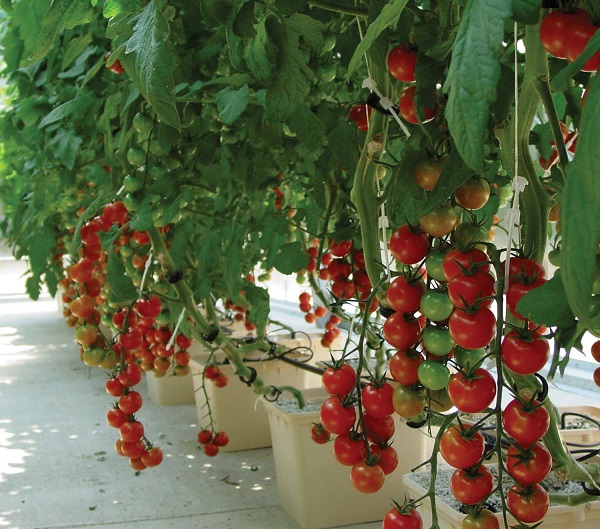Hydroponic greenhouses can produce larger yields than a traditional greenhouse but for maximum success the grower must understand what to grow and what not to grow. Some plants may spread out too much to grow properly in a hydroponic greenhouse. Other plants may be cool weather plants and will not be able to stand the constant high temperatures that other plants may need to thrive in. Then there are other plants that need special attention, if you decide to grow them in a hydroponic greenhouse.
Plants to Grow in a Hydroponic Greenhouse
Strawberries
Strawberries are one fruit that does quite well in this type of growing environment. Plants of this fruit are compact enough to fit in with the usual layouts of hydroponic greenhouses. You can set the plants out in a number of configurations and they will still thrive. Also, there are so many varieties to choose from depending on the size of berry and level of sweetness desired.
Potatoes
Potatoes and other root crops also work well, but only if they are given enough depth to grow adequately. You have to remember with these crops that they do a lot of their growing in the root area as well as up in their stems and foliage. If they are cramped for space, it will stunt their growth. You can choose the smaller varieties of the root crops, when available to help offer them enough depth.

Tomatoes
Tomatoes thrive when grown hydroponically. Of course, they need to have a support system with this type of greenhouse setting just as they do in a traditional greenhouse or garden setting. Some varieties grow larger than other ones though, so choose the type you think you can provide the best support for in your particular setup. Some other vining veggies that need support include peas, cucumbers and pole beans.
Mint
There are many varieties of mint that do well in a hydroponic greenhouse, because they enjoy wet conditions. Mints spread quite a bit and should be given enough space. Other than this requirement, your chosen mint whether it be peppermint, spearmint, ginger mint or another type of mint should produce nicely for you.
Basil
Basil is another herb to grow in your hydroponic garden. The moist conditions provided to the herb through this system actually enhance its flavor. As with other plants, your yield will most likely increase with using hydroponic methods of gardening. Many other herbs do well too, but you need to check the growing conditions they need to make sure before planting them.
Lettuce
Various types of lettuce will provide you with more flavorful harvests. Some people only think of iceberg variety when lettuce is mentioned, but there is romaine, sweet butter and many more to choose from for growing your salad greens hydroponically.
Cabbage
Cabbage is one of the cool weather vegetables that does well in this environment. You may need to adjust growing conditions for the cool weather vegetables. This means you may need to grow the plants according to their natural seasons. You can change the temperature settings in your greenhouse according to the crops you decide to cultivate.
Green Beans
Bush-style green beans will adjust quite well with the typical conditions set up in a hydroponic system. You will be able to harvest plenty for your table and have additional beans to can or freeze. The size of these is easier to deal with than the pole beans, even though with the right support, as mentioned earlier, you can also grow pole beans.
Grow What you Eat
You also need to think of which vegetables you and your family will eat when growing them hydroponically. Remember, your harvests are likely to be larger using this method and therefore, you will not want to concentrate on crops you do not like to eat. Now, there are some things you should not or would have a hard time growing in a hydroponic setup.
Plants to Not Grow in a Hydroponic Greenhouse
Plants that take up a great deal of space to grow are impractical to grow in this type of greenhouse. Watermelon and other melons, squash, and corn are some of these vegetables. They all take a huge amount of space to grow.
Some pumpkin varieties are geared to grow huge. Allow pumpkins all the space they need by planting them outside where they can spread and increase in size all they want. After all, you do not want to wind up with the pumpkin that ate your hydroponic greenhouse do you?
Many plants need the bees to pollinate them, because they have both male and female flowers on them. These plants are a bit labor intensive to grow hydroponically, since you have no bees inside the structure. However, if you are willing to learn the painstaking task of pollinating these plants yourself, some of them will still do well in this setting.
Flowers have varied growing conditions, so you can’t just grow any of them with success. You will need to research into each kind to see if any will work for you. Until you are sure of what varieties to grow, stay away from flowers for this type setup.
Of course, you can try to grow anything you want, as long as you realize not all things may come out as ideally as you would like. If you are new to hydroponic gardening though, set yourself up for success and start with vegetables and plants that have worked well for others. Then you can experiment, as you learn more information. This way, you get some pleasing results your first go around.
Information for this article was provided by DIY Greenhouse Gardening Plans DIYGreenhousePlans.info.
Related Articles & Free Email Newsletter Subscription
A Hydroponic Wick System is Easy to Build and Great for Beginners
Hydroponics is as Easy as NFT!




Comment here